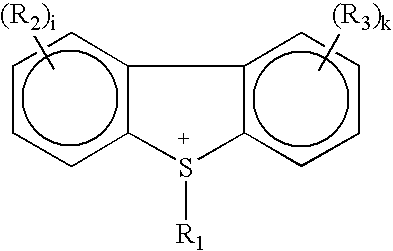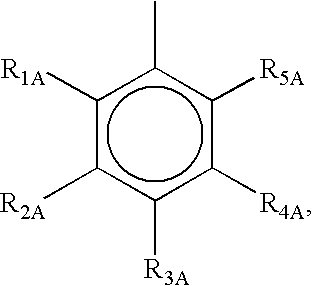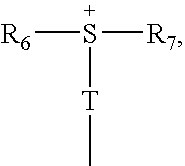Photoactive compounds
a technology of photoactive compounds and compounds, applied in the field of photoactive compounds, can solve the problems of critical roughness of photoresist patterns, adverse effects of edge roughness on the lithographic performance of photoresist,
- Summary
- Abstract
- Description
- Claims
- Application Information
AI Technical Summary
Benefits of technology
Problems solved by technology
Method used
Image
Examples
example 1
Synthesis of bis(triphenyl sulfonium)perfluorobutane-1,4-disulfonate
[0062]
[0063] Perfluorobutane-1,4-disulfonic acid potassium salt (2.5 g) was added to a solution of triphenyl sulfonium bromide (3.5 g) in 150 ml of water. Chloroform (150 ml) was added and stirred for 5 hours. The chloroform layer was washed several times with water, dried over anhydrous sodium sulfate, filtered, and the filtrate evaporated to an oil stage. Ether was added to the oil and the mixture was stirred vigorously. A white precipitate formed. The mixture was filtered and recovered precipitate was dried under vacuum, resulting in a white powder; mp 155° C.
example 2
Synthesis of bis(triphenyl sulfonium)perfluoropropane-1,3-disulfonate
[0064]
[0065] Perfluoropropane-1,3-disulfonic acid lithium salt (3.0 g) in 60 ml water was added to a solution of triphenyl sulfonium bromide (6.0 g) in 120 ml of water. Dichloromethane (200 ml) was added and stirred for 5 hours. The dichloromethane layer was washed several times with water, dried over anhydrous sodium sulfate, filtered, and the filtrate evaporated to an oil stage. Ether was added to the oil and the mixture was stirred vigorously. A white precipitate formed. The mixture was filtered and recovered precipitate was dried under vacuum, resulting in a white powder; mp 161° C.
example 3
Synthesis of bis(4-t-Butylphenyl iodonium)triphenyl sulfonium perfluorobutane-1,4-disulfonate
[0066]
[0067] 4.73 g of triphenyl sulfonium bromide was dissolved in water in a flask. Bis(4-t-butylphenyl iodonium)acetate (6.24 g) was dissolved in acetone and added to the flask. Perfluorobutane-1,4-disulfonic acid (5.0 g) was then added to the mixture and the mixture was stirred over night at room temperature. Bis(4-t-butylphenyl iodonium)triphenyl sulfonium perfluorobutane-1,4-disulfonate was isolated as in Example 1 (mixture of compounds); mp 93° C.
PUM
| Property | Measurement | Unit |
|---|---|---|
| roughness | aaaaa | aaaaa |
| wavelengths | aaaaa | aaaaa |
| wavelengths | aaaaa | aaaaa |
Abstract
Description
Claims
Application Information
 Login to View More
Login to View More - R&D
- Intellectual Property
- Life Sciences
- Materials
- Tech Scout
- Unparalleled Data Quality
- Higher Quality Content
- 60% Fewer Hallucinations
Browse by: Latest US Patents, China's latest patents, Technical Efficacy Thesaurus, Application Domain, Technology Topic, Popular Technical Reports.
© 2025 PatSnap. All rights reserved.Legal|Privacy policy|Modern Slavery Act Transparency Statement|Sitemap|About US| Contact US: help@patsnap.com



